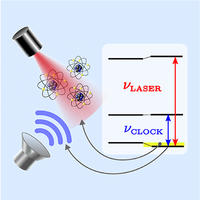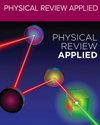利用紧凑型原子钟的光偏移实现激光稳频
IF 4.4
2区 物理与天体物理
Q2 PHYSICS, APPLIED
引用次数: 0
摘要
本文介绍了光变激光锁定(LSLL)技术,这是一种用于基于激光的紧凑型原子钟的替代方法。该技术通过将抽运激光频率稳定在时钟运行所涉及的相同原子上,无需外部参考,从而大大简化了激光设置。通过交替使用两个时钟序列,该方法可以估算并消除作用于激光频率的受控诱导光偏移量。LSLL 技术与最先进的三电平时钟兼容,并通过 INRIM 开发的基于场可编程栅极阵列的电子器件,在脉冲光泵蒸汽电池时钟上进行了演示。结果表明,LSLL 技术运行稳定,捕获范围达千兆赫兹,且不会明显影响时钟稳定性。在我们的测试中,时钟在平均时间 τ 高达 4000 秒时的白频噪声为 3.2×10-13τ-1/2,在 100 000 秒时的最低噪声低于 1×10-14。这一性能水平符合未来全球导航卫星系统机载时钟的要求,同时还具有减少时钟占用空间、提高可靠性和坚固性的优点。本文章由计算机程序翻译,如有差异,请以英文原文为准。

Laser-frequency stabilization using light shift in compact atomic clocks
This paper describes the light-shift laser-lock (LSLL) technique, an alternative method intended for laser-based compact atomic clocks. The technique greatly simplifies the laser setup by stabilizing the pumping-laser frequency to the same atoms involved in the clock operation, without the need of an external reference. By alternating two clock sequences, the method estimates and cancels out a controlled amount of induced light shift, acting on the laser frequency. The LSLL technique is compatible with state-of-the-art three-level clocks and was demonstrated with field-programmable-gate-array-based electronics on a pulsed-optically-pumped vapor-cell clock developed at INRIM. The results have shown that the LSLL technique operates robustly, having a capture range of gigahertz without significantly compromising clock stability. In our tests, the clock exhibited a white frequency noise of for averaging times up to 4000 s, reaching a floor below 1× up to 100 000 s. This level of performance meets the requirements of future global navigation satellite systems on-board clocks, adding the benefits of a reduced clock footprint, as well as increased reliability and robustness.
求助全文
通过发布文献求助,成功后即可免费获取论文全文。
去求助
来源期刊

Physical Review Applied
PHYSICS, APPLIED-
CiteScore
7.80
自引率
8.70%
发文量
760
审稿时长
2.5 months
期刊介绍:
Physical Review Applied (PRApplied) publishes high-quality papers that bridge the gap between engineering and physics, and between current and future technologies. PRApplied welcomes papers from both the engineering and physics communities, in academia and industry.
PRApplied focuses on topics including:
Biophysics, bioelectronics, and biomedical engineering,
Device physics,
Electronics,
Technology to harvest, store, and transmit energy, focusing on renewable energy technologies,
Geophysics and space science,
Industrial physics,
Magnetism and spintronics,
Metamaterials,
Microfluidics,
Nonlinear dynamics and pattern formation in natural or manufactured systems,
Nanoscience and nanotechnology,
Optics, optoelectronics, photonics, and photonic devices,
Quantum information processing, both algorithms and hardware,
Soft matter physics, including granular and complex fluids and active matter.
 求助内容:
求助内容: 应助结果提醒方式:
应助结果提醒方式:


